Top 9 Frameworks in the World of Artificial Intelligence
Top 9 Frameworks in the World of Artificial Intelligence
Gone are the times where AI was considered to be fictional.
From robots to the Google Siri and now the introduction of the new Google Duplex, Artificial intelligence seems to have taken considerable strides to become more and more humane.
The demand for machine learning and AI has grown exponentially. Additionally, the community itself has increased as a result, and that has lead to the evolution of some AI frameworks which make learning AI much easier.
In this article, we shall discuss some of the best frameworks to get you started with AI development.
1. Tensor Flow

Hailing from the Google family, Tensor Flow proves to be a robust open source framework that supports deep learning and which can be accessed even from a mobile device.
Tensor flow is considered an apt tool for statistic program development. As it offers distributed training, machine models can be trained a lot more effectively at any level of abstraction that the user prefers.
Features
- A scalable multi programming interface for easy programming
- Strong growth drivers, with a strong open source community
- Provides extensive and well-documented manuals for people
Pros
- The language used by tensor flow is Python, which is very popular nowadays.
- This framework is capable of high computational power. Hence, it can be used on any CPU or GPU.
- Uses computational graph abstraction to create machine models
Cons
- To make a decision or prediction, the framework passes the input data through multiple nodes. This can be time-consuming.
- It also lacks many of the pre-trained models of AI.
2. Microsoft CNTK
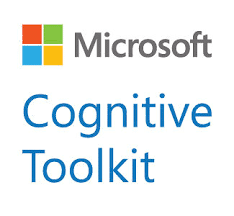
Microsoft CNTK is a faster, and versatile open source framework that is based on neural networks which support text, message, and voice remodeling.
It provides an efficient scaling environment due to a faster overall evaluation of the machine models while taking care of accuracy.
Microsoft CNTK has integrations with major massive datasets making it the leading choice to be adopted by big players like Skype, Cortana, etc., with a very expressive easy to use architecture as well.
Features
- Highly optimized to provide efficiency, scalability, speed and high-level integrations
- Has built-in components such as hyperparameter tuning, supervised learning models, reinforcement, CNN, RNN, etc.
- Resources are utilized to provide the best efficiency.
- Own networks that can be expressed efficiently such as full APIs, both high level and low level
Pros
- As it supports Python and C++, this framework can work with multiple servers at once and hence makes the learning process quicker.
- It has been developed keeping in mind about the recent developments in the world of AI. Microsft CNTK’s architecture supports GAN, RNN, and CNN.
- It permits distributed training to train machine models effectively.
Cons
- It lacks a visualization board and mobile ARM support.
3. Caffe
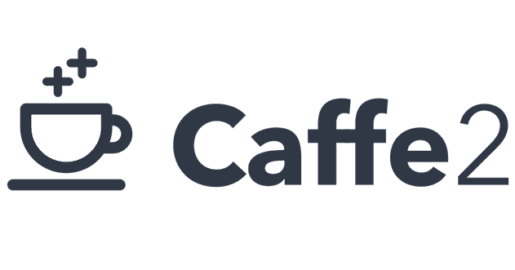
Caffe is a deep learning network that comes along with the preloaded set of trained neural networks. This should be your first pick if your deadline is close.
Known for its image processing capabilities, this framework also has extended support of MATLAB.
Features
- All of its models are written in plaintext schemas
- Offers massive speed and highly efficient work since it is already preloaded.
- An active open source community for discussion and collaborative code.
Pros
- Interlinking C, C++, and Python, it also supports the modeling of CNN(convolutional neural networks)
- Efficient when computing numerical tasks due to its speed.
Cons
- Caffe is not capable of handling complex data but is comparatively fast while handling visual processing of images.
4. Theano
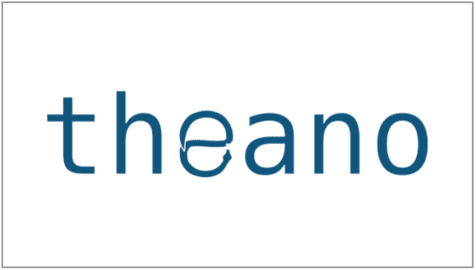
Using GPUs in place of CPU, this framework supports deep learning research and is capable of delivering accuracy for networks that need high computational power. For instance, computation of multi-dimensional arrays requires high power and Theano is capable of that.
Theano is based on python which is a proven programming language when it comes to faster processing and response.
Features
- Evaluation of expressions are faster due to dynamic code generation
- Provides an excellent accuracy ratio even when values are minimal.
- Unit testing is a significant feature of Theano, as it allows the user to self-verify their code as well as detect and diagnose errors easily.
Pros
- Theano offers efficient support for all the data-intensive applications but requires combining with other libraries.
- Efficiently optimized for the CPU as well as the GPU
Cons
- There will be no more update or addition of features to the current version of Theano.
5. Amazon machine learning
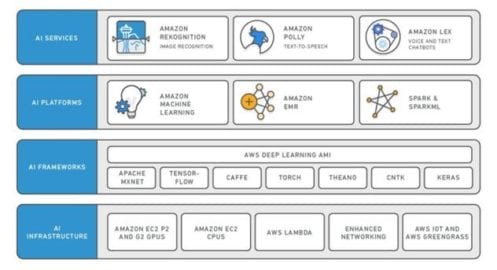
Being a trending entrant to the AI community, Amazon machine learning offers high-end support in the development of self- learning tools.
This framework already has existing user bases in its multiple services like AWS, S3 and Amazon Redshift. This is a managed service by Amazon, with three operations performed on the model, which are data analysis, training of model and evaluation.
Features
- There are tailored Tools for every level of experience in the AWS even if you are a beginner, data scientist or developer
- Security is of utmost importance, so all data is encrypted
- Provides extensive tools for data analysis and comprehension
- Integrations with all major datasets
Pros
- You don’t need to write a lot of code with this framework. Instead, it lets you interact with AI-powered framework via API’s.
- Commonly used by data scientists, developers and ML researchers.
Cons
- It lacks flexibility as the entire framework is abstracted so if you’d like to choose a particular normalization or machine learning algorithm, you can’t.
- It also lacks data visualization.
6. Torch

The Torch is an open source framework that could support numerical operations. It offers numerous algorithms for faster development of deep learning networks.
It is used extensively in the AI labs of Facebook and Twitter. There is a python based framework known as PyTorch which has proven to be simpler and more reliable.
Features
- Features a lot of routines to index, slice, transpose with an N-dimensional array model
- Optimization routines are present, primarily numeric based with neural network models
- GPU support is highly efficient
- Integrates easily with the iOS and Andriod
Pros
- Very high flexibility regarding languages and integrations
- High level of speed and GPU utilization efficiency
- Pre-existing models are available to train the data on.
Cons
- Documentation is not very clear to the users, so it presents a steeper learning curve
- Lack of code for immediate use so it takes time.
- It is initially based on a programming language called Lua, and not many are aware of it.
7. Accord.Net
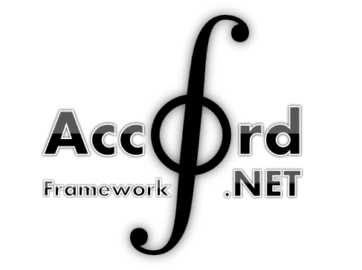
Accord.net is a C# based framework which assists in the development of neural networks used for audio and image processing.
Applications can use this commercially as well to produce computer vision applications, signal processing as well as statistics applications.
Features
- Mature, well-tested codebase, as it was started in 2012
- Provides a comprehensive set of sample models and datasets to get your application started quickly
Pros
- It is continuously supported by an active development team.
- This well-documented framework which efficiently handles numerical intensive computation and visualization
- Implementation of algorithms and signal processing can be performed conveniently with this framework.
- It can easily handle numerical optimization and artificial neural networks.
Cons
- It is not very well known when compared to other frameworks.
- Its performance is slower compared to other frameworks.
8. Apache Mahout
Apache Mahout, being an open source framework, aims at the development of scalable machine learning frameworks. It doesn’t deal with APIs as such but helps in the implementation of new machine learning algorithms by data scientists and engineers.

Features
- Known for it’s Scala DSL which is mathematically very expressive
- Extends support to multiple backends which are distributed.
Pros
- It aids in clustering, collaborative filtering, and classification.
- Its computational operations make use of Java libraries, which is faster.
Cons
- Python libraries are not as compatible as Java libraries with this framework.
- Its computational operations are slower than Spark MLib.
9. Spark MLib
Spark MLib framework by Apache is supported by R, Scala, Java, and Python. It can be loaded with Hadoop workflows for providing machine learning algorithms such as classification, regression, and clustering.
Apart from Hadoop, it can also be integrated with the cloud, Apache or even standalone systems.
Features
- High performance is one of the key elements and is said to be 100 times faster than MapReduce
- Spark is exceptionally versatile and runs in multiple computing environments
Pros
- It can process vast amounts of data quickly, as it works on iterative computation.
- It is available in many languages and easily pluggable.
- It cycles large scales of data processing with ease.
Cons
- It can be plugged with Hadoop only.
- It is difficult to understand this framework’s mechanism, without extensive work on the same
AI Framework Comparision
| Framework | Language | Opensource? | Features of Architecture |
| TensorFlow | C++ or Python | Yes | Uses data structures |
| Microsoft CNTK | C++ | Yes | GPU/CPU based. It supports RNN, GNN, and CNN. |
| Caffe | C++ | Yes | Its architecture supports CNN |
| Theano | Python | Yes | Flexible architecture allowing it to deploy in any GPU or CPU |
| Amazon Machine Learning | Multiple languages | Yes | Hailing from Amazon, it uses AWS. |
| Torch | Lua | Yes | Its architecture allows powerful computations. |
| Accord.Net | C# | Yes | Capable of scientific computations and pattern recognition. |
| Apache Mahout | Java, Scala | Yes | Capable of making machines learn without having to program |
| Spark MLib | R, Scala, Java and Python | Yes | Drivers, and executors run in their processors. Horizontal or vertical clusters. |
I hope above helps you to choose the AI framework for your next modern application development.
If you are a developer and looking to learn deep learning to get into AI, then you may consider taking this specialized online course by Coursera.
Comments
Post a Comment